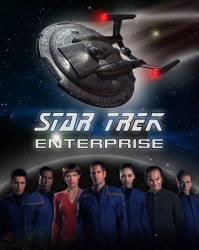In a Mirror, Darkly (1) - S4-E18
Trivia: In the opening scene of this episode (S4E18), footage from the 1996 movie "Star Trek: First Contact" was ingeniously intercut with new footage to create a startling revision that is still a Star Trek fan favorite to this day. Actors James Cromwell (Zefram Cochrane) and Cully Fredricksen (the Vulcan emissary) shot the original scene for the film "First Contact" in 1995. When the TV series "Star Trek: Enterprise" recycled the movie footage 10 years later, both Cromwell and Fredricksen received a day's pay for appearing as extras in this TV episode (about $120 for a day's work in 2005), even though they never physically appeared on the "Enterprise" set.
Trivia: A film reference to Star Trek: First Contact: Archer says something about a group of cybernetic creatures (The Borg), that tried to stop Cochrane from launching his mission into space that was stopped by a group of humanoids, that were also from the future (USS Enterprise NCC 1701-E).
Trivia: Season 3 of Enterprise is the only season of any Star Trek series to date in which no Klingons appear.
Acquisition - S1-E19
Trivia: One of the Ferengi, Ulis, is played by Ethan Phillips. Phillips played Neelix in "Star Trek: Voyager." In S3 E5 of Voyager, "False Profits", Neelix disguised himself as a Ferengi.
Trivia: Trip tells Malcolm, "if I remember my honors biology course correctly, your hair and nails keep growing for quite a while after you're dead." However, this is a myth and would never be taught in any biology class, especially in the future. Nothing keeps growing after you're dead, as the skin dries out, and the body decomposes, the skin retracts and just makes the hair and nails look longer. This is more likely a mistake, but since it's possible Trip isn't a biology expert, forgot his honors biology, or is just teasing Malcolm, it should be noted as trivia.
Trivia: When Travis is in his old room talking with Nora about Enterprise, look on the bookshelf behind Travis. There's a large white book about Chicago gangs of the 1920's. In the original series episode "A Piece of the Action" it is determined that 100 years ago the ship Horizon accidentally left a book about Chicago gangs which influenced the entire culture to mimic the mobster lifestyle. (00:20:55)
Trivia: T'Pol tells Archer that they're on the fifth planet in the Ceti Alpha system, the same planet where Kirk maroons Khan in TOS episode, "Space Seed." Even more tragic is that anyone who's seen Star Trek II The Wrath of Khan will know that this planet, Ceti Alpha V, will be rendered virtually uninhabitable in a little over 100 years when Ceti Alpha VI explodes. So what's left of humanity has traded one destroyed world (Earth) for a ticking time bomb.
Trivia: The space shuttle Enterprise appears in the title sequence of the show - this shuttle was named after the Enterprise from the original series (after a poll, and also because Star Trek was President Carter's favourite show). A case of reality imitating art and then art imitating that reality.
Trivia: The character of T'Pol was originally going to be T'Pau, the Vulcan high priestess who appears in the original series episode "Amok Time" and in the film Star Trek III: The Search for Spock. Her name was changed because per WGA rules, the scriptwriter who'd written "Amok Time" would have had to be paid a royalty for every episode.
Trivia: Season 4 of Enterprise is the first season of any TV show to be shot entirely on digital film.
These Are the Voyages ... - S4-E22
Trivia: Riker is viewing the crew manifests for the USS Pegasus. The second person he looks at (the woman) is called Lt. Dawn Velazquez - a member of the production team.
Carbon Creek - S2-E2
Trivia: One of the Vulcans that crash at Carbon Creek is named "Mestral." At the end of the episode, T'Mir sells her invention, a hook and loop fastener. Velcro, in real life, was invented by George de Mestral.






Answer: Acording to the Star Trek Encyclopedia Cochrane was born in 2030. His warp flight was in 2063, and he himself disappeared from Alpha Centauri in the year 2117 at 87. Kirk met him on a planetoid in the Gsmms Canaris region in the year 2267 making him 237. The first episode of Enterprise is in 2151, so Cochrane was missing for 34 years by that time and would have been 121 at that time.
Garlonuss ★